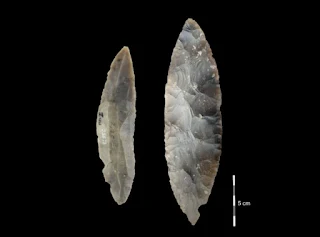DNA from bones found in a cave in Germany has been identified as from Homo sapiens, showing that our species endured frigid conditions there as they expanded across the continent
(Credit: Dorling Kindersley / Getty Images)
When modern humans first began settling in Europe, they went straight to the cold north. A challenging excavation in Germany places our species in the region at least 45,000 years ago – and supports earlier claims that our ancestors were in Britain not long after.
“These guys came into a landscape which was quite hostile,” says Jean-Jacques Hublin at the Max Planck Institute for Evolutionary Anthropology in Leipzig, Germany. “It was like northern Finland [today].”
Modern humans (Homo sapiens) are the most recent hominin to permanently settle in Europe, around 45,000 years ago. Previously, the continent was dominated for hundreds of thousands of years by Neanderthals, who vanish from the fossil record about 40,000 years ago. Modern humans and Neanderthals may have overlapped in France and Spain for 1400 to 2900 years.
“The replacement of all archaic humans by Homo sapiens, between 50,000 and 40,000 years ago, is something that occurred all over Eurasia,” says Hublin. It was a crucial period because for millions of years there had been multiple hominins coexisting, but now only one survived.
“This is the start of one species invading all the possible habitable niches on the Earth,” says Hublin. “We know it happened… but we don’t know why and how it happened.”
The transitional period is mysterious. There are several types of stone artefacts from the period that could have been made by Neanderthals or modern humans. One, found in several sites in northern Europe, is the Lincombian-Ranisian-Jerzmanowician (LRJ) – characterised by long, leaf-shaped points that may have been fitted to spears. They had never been found in association with confidently identified hominin bones. “We had no clue who made them,” says Hublin.
To find out, Hublin and his colleagues visited several sites that had yielded LRJ artefacts. Unfortunately, previous archaeologists had destroyed the sites with crude excavation methods. The one exception was a cave called Ilsenhöhle near Ranis, Germany. It collapsed thousands of years ago, so the initial excavations in the 1930s were difficult and some of the site remained undisturbed. Hublin’s team re-excavated it, digging a deep shaft down to the relevant sediment layer.
 |
| So-called LRJ stone tools found at IIsenhöhle cave in Germany (Credit; Josephine Schubert, Museum Burg Ranis) |
It was an “exceptionally difficult” excavation, says Marie Soressi at Leiden University in the Netherlands, who wasn’t involved in the study.
Buried in the sediments, Hublin’s team found many fragments of bone. They also re-examined similar fragments from the original excavations. By analysing the collagen protein in the bones, they determined that 13 belonged to hominins. To identify them more precisely, the team extracted mitochondrial DNA, which people inherit solely from their mothers, from 11 of the fragments. “They are Homo sapiens,” says Hublin.
The techniques used were “top-notch”, says Soressi. She wants to see nuclear DNA as well, to be sure, because it is possible the individuals were hybrids with Neanderthal fathers – which mitochondrial DNA wouldn’t show. However, she says this is “very unlikely”.






0 Comments